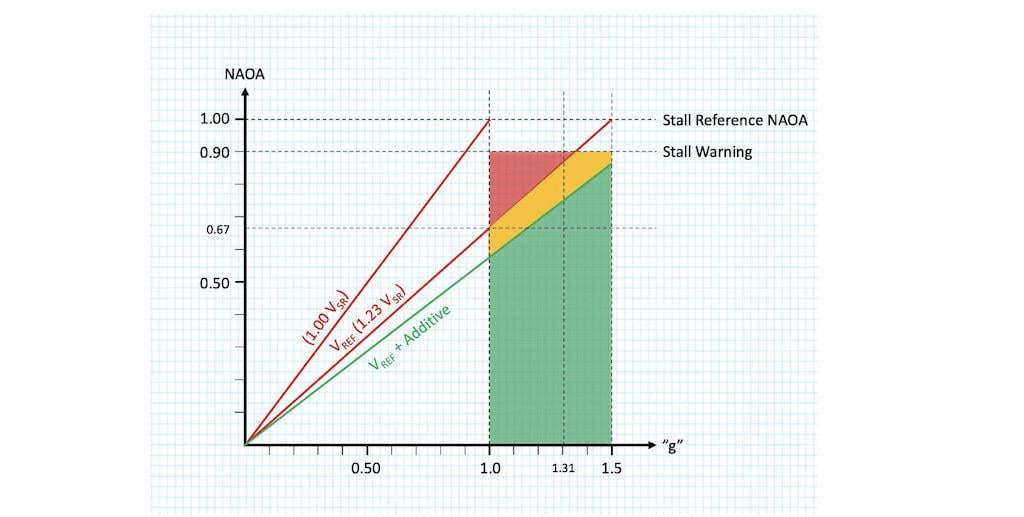
NAOA vs. G-loading on a notional aircraft.
Most pilots understand that Reference Speed, VREF, is a minimum speed that they should never go below during approach and landing, and that is certainly true. But many take that idea one step further, thinking that as long you are above VREF, you are safe from stalling the aircraft. That is not true at all.
The July 26, 2021, crash of a Bombardier Challenger 605 at Truckee Tahoe Airport, California (KTRK), revealed how a weight and balance error that resulted in a VREF computed 6 kt. too low combined with poor circling procedures to doom the crew and passengers to a stall and crash, killing all on board. An examination of this accident gives us much to consider, including the primal idea of “how slow can you fly?”
The case study’s Pilot In Command (PIC) was clearly well behind the aircraft after shooting the RNAV (GPS) Runway 20 and commencing a circle to Runway 11. He had maneuvered the aircraft too close to the runway to make a successful turn to final and stalled the aircraft. The Pilot Monitoring (PM) said “Let me have the airplane” three times in the 7 sec. prior to the stall and crash, which killed both pilots and their four passengers.
There is much to unpack here, and I’ll leave most of that for your study. I would like to consider here what exactly is it that VREF gives you by way of “stall insurance,” and how you can improve your odds with some knowledge you probably did not get in flight school.
What does VREF really mean? A transport category aircraft is designed under certification rules that say, “A stabilized approach, with a calibrated airspeed of not less than VREF must be maintained down to the 50-ft. height.” Regulation 14 CFR 25.125(b)(2) goes further to say that “in nonicing conditions, VREF may not be less than 1.23 VSRO, VMCL established under §25.149(f); and a speed that provides the maneuvering capability specified in §25.143(h).” Further unpacking tells us that VSRO is the reference stall speed in the landing configuration. VMCL established under §25.149(f) is the minimum control speed during approach and landing with all engines operating when the critical engine is made inoperative. The maneuvering capability specified in §25.143(h) allows for a 40-deg. bank angle in a coordinated turn while the thrust is set to provide for a -3-deg. flightpath angle.”
If you are thinking this means you have a 23% margin over the stall while in a 40-deg. bank turn, you are mistaken. VSR is determined by the manufacturer but may not be less than a 1g stall speed. While on approach in 1g flight, you do indeed have a 23% margin over the stall, and you can maneuver with up to a 40-deg. bank in a coordinated turn. But when you maneuver, you are “eating into” that margin.
Looking at the Normalized Angle of Attack (NAOA) versus the G-loading of a notional aircraft can help illustrate the point.
NAOA is simply the ratio of your AOA to the stall AOA. While AOA is measured in units of degrees, NAOA has no units at all, since it is a ratio. If you have an AOA gauge in the cockpit that goes from 0 to 1.0, or perhaps a bit higher, it is really presenting you with NAOA.
Examining our chart (above), we see that flying at 1.0g, the aircraft reaches stall NAOA at VSR. You could increase your speed, which drops the line lower, but you could also unload the aircraft, which moves you to the left along the 1.00 VSR line and decreases your NAOA. Notice that increasing your speed to VREF, which is 1.23 VSR for many aircraft, our NAOA drops to 0.67 and greatly increases our margin over the stall. But notice also that if you “load up” the aircraft to 1.5g, you find yourself at stall NAOA again.
How many G’s are you pulling at 40 deg. of bank? From primary flight school you know that 60 deg. of bank gets you to 2.0g. You were probably never shown the math behind that:
G= 1/cos60 =2.00g
As it turns out:
G=1/cos40 =1.31g
Which tells us that flying at VREF with the wings level gives us a healthy stall margin but flying a 40-deg. bank turn in level flight at that same speed reduces that margin considerably. That gives us a clue in the Challenger crash at Truckee. Their VREF was computed 6 kt. too low because of a weight and balance error, raising their NAOA. The PF banked the aircraft, further raising their NAOA to the point they stalled.
Challenger pilots have two handicaps when maneuvering their aircraft at speeds near VREF. First, they are told: “The AOA display function is advisory only and indicated airspeed must always be used as the primary reference.” Second, the aircraft will almost always drop a wing when stalling, exacerbating the situation by further raising that wing’s angle of attack.
This newest Challenger did have one advantage over older models: a low-speed awareness cue on the airspeed tape that is AOA-based. Even with a VREF computed in error and a G-induced increase in NAOA, pilots who add the low-speed awareness band to their crosscheck will know they need to decrease their angle of attack no matter what their airspeed indicators are saying.
The lessons learned here are many and apply to all aircraft: VREF is a minimum, not a target. Your actual airspeed target needs to go up with any kind of G-loading, be that from a turn or gusty winds. Both of those elements tend to happen during circling maneuvers, where added speed increases turn radius. It is yet another reason a circling approach requires a steady hand and an abundance of caution.

